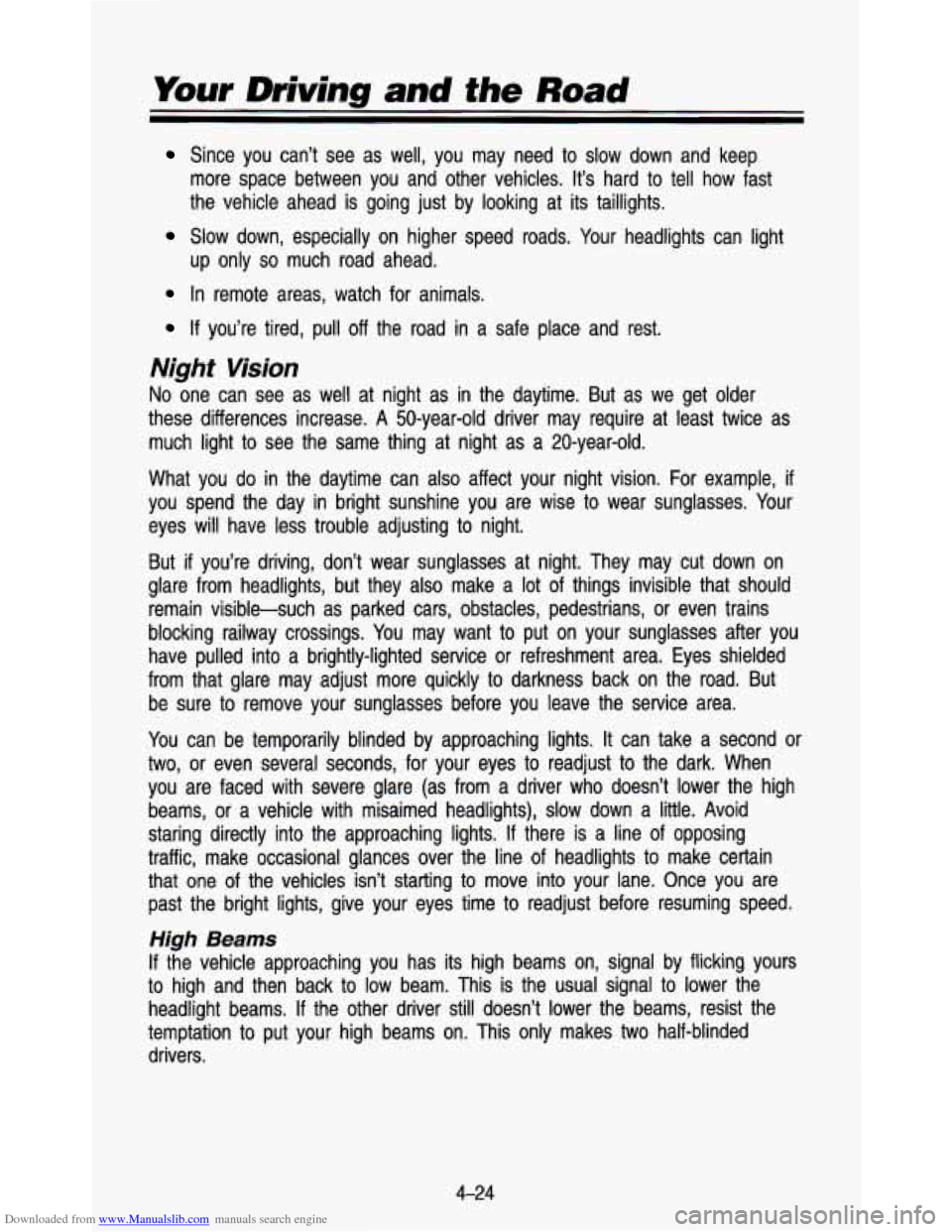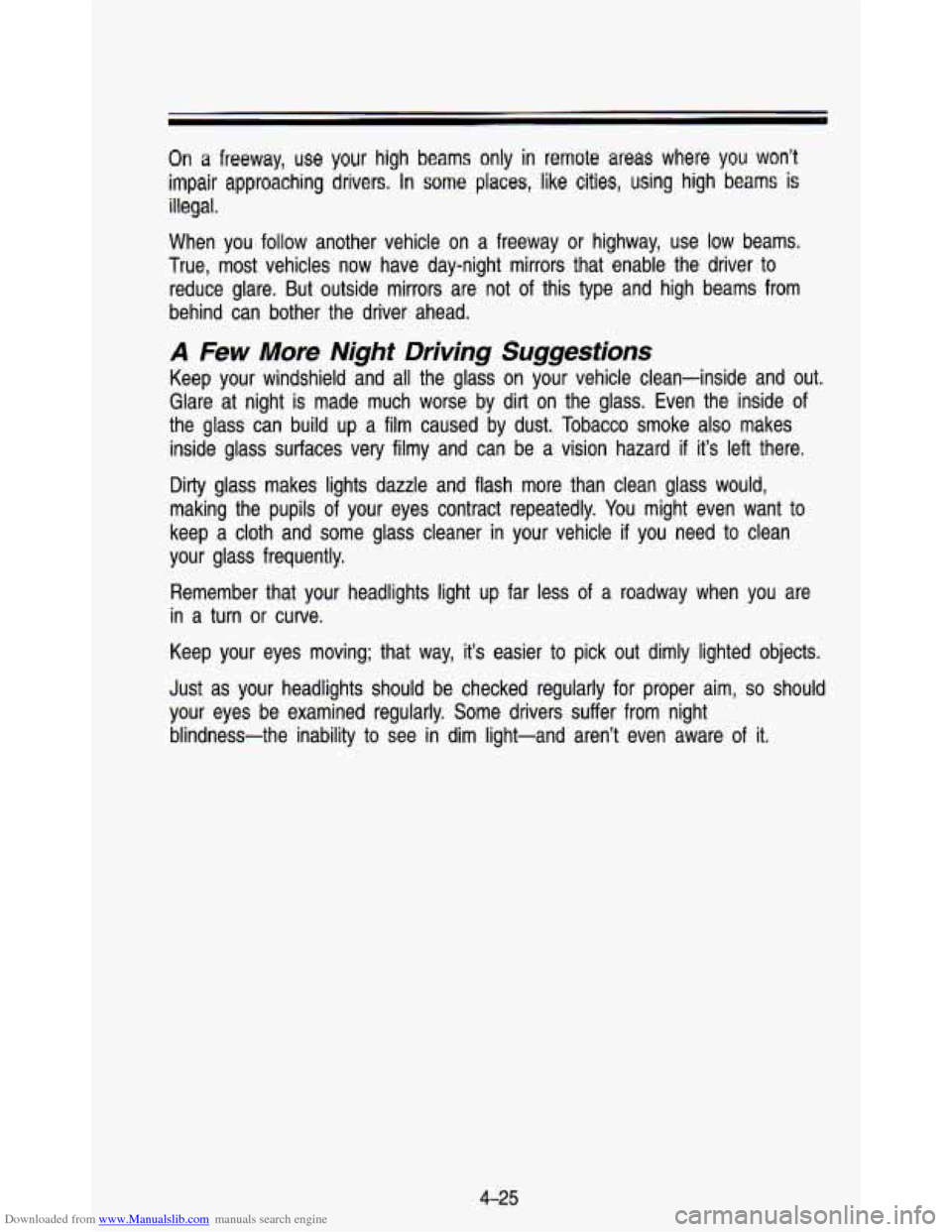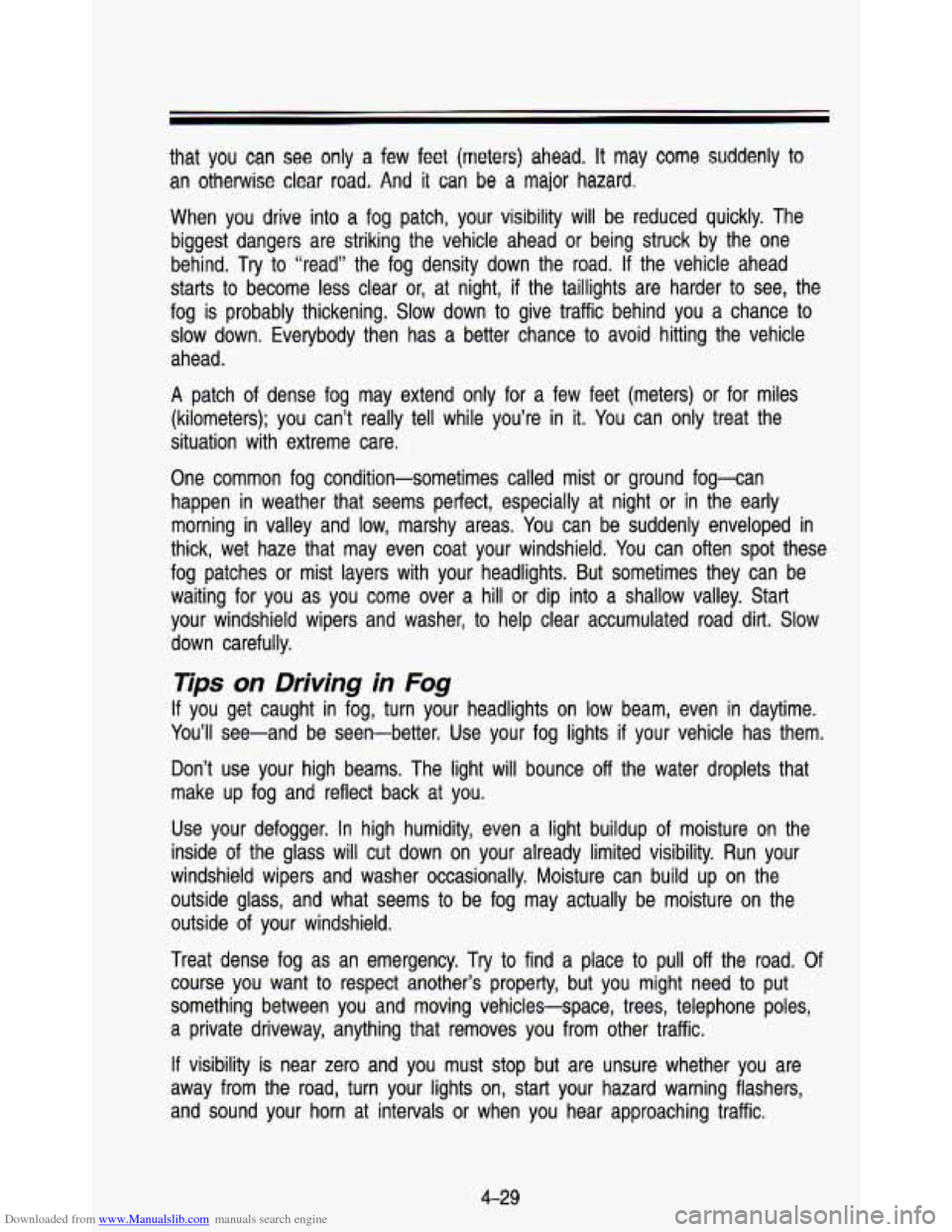1993 CHEVROLET ASTRO PASSENGER low beam
[x] Cancel search: low beamPage 178 of 345

Downloaded from www.Manualslib.com manuals search engine Your Driving and the Road
Since you can’t see as well, you may need to slow down an\
d keep more space between you and other vehicles. It’s hard to tel\
l how fast
the vehicle ahead is going just by looking at its taillights. \
Slow down, especially on higher speed roads. Your headlights can light
up only
so much road ahead.
In remote areas, watch for animals.
If you’re tired, pull off the road in a safe place and rest.
Night Vision
No one can see as well at night as in the daytime. But as we \
get older
these differences increase.
A 50-year-old driver may require at least twice as
much light to see the same thing at night as a 20-year-old.
What you
do in the daytime can also affect your night vision. For example, if
you spend the day in bright sunshine you are wise to wear su\
nglasses. Your
eyes will have less trouble adjusting to night.
But
if you’re driving, don’t wear sunglasses at night. They may \
cut down on
glare from headlights, but they also make a lot of things inv\
isible that should remain visible-such as parked cars, obstacles, pedestrians,
or even trains
blocking railway crossings. You may want to put on your sunglasses after you
have pulled into a brightly-lighted service
or refreshment area. Eyes shielded
from that glare may adjust more quickly to darkness back on t\
he road. But be sure to remove your sunglasses before you leave the service area.
You can be temporarily blinded by approaching lights. It can take a second
or
two, or even several seconds, for your eyes to readjust to the dark. When
you are faced with severe glare (as from a driver who doesn’\
t lower the high beams,
or a vehicle with misaimed headlights), slow down a little. Avoid\
staring directly into the approaching lights.
If there is a line of opposing
traffic, make occasional glances over the line
of headlights to make certain
that one of the vehicles isn’t starting to move into your \
lane. Once you are past the bright lights, give your eyes time to readjust before resuming speed.
High Beams
If the vehicle approaching you has its high beams on, signal by \
flicking yours
to high and then back to low beam. This is the usual signal \
to lower the
headlight beams.
If the other driver still doesn’t lower the beams, resist the
temptation to put your high beams on. This only makes
two half-blinded
drivers.
4-24
Page 179 of 345

Downloaded from www.Manualslib.com manuals search engine On a freeway, use your high beams only in remote areas where you won’t
impair approaching drivers, In some places, like cities, using high beams is
illegal.
When you follow another vehicle on a freeway or highway, use
low beams.
True, most vehicles now have day-night mirrors that enable the \
driver to reduce glare. But outside mirrors are not of this type and hi\
gh beams from
behind can bother the driver ahead.
A Few More Night Driving Suggestions
Keep your windshield and all the glass on your vehicle clean-i\
nside and out.
Glare at night is made much worse by dirt on the glass. Even the inside
of
the glass can build up a film caused by dust. Tobacco smoke also makes
inside glass surfaces very filmy and can be a vision hazard
if it’s left there.
Dirty glass makes lights dazzle and flash more than clean glas\
s would,
making the pupils
of your eyes contract repeatedly. You might even want to
keep a cloth and some glass cleaner in your vehicle if you need to clean
your glass frequently.
Remember that your headlights light up far less of a roadway when you are
in a turn or curve.
Keep your eyes moving; that way, it’s easier to pick out dimly lighted objects.
Just as your headlights should be checked regularly for proper \
aim,
so should
your eyes be examined regularly. Some drivers suffer from night\
blindness-the inability to see in dim light-and aren’t even aware of it.
4-25
Page 183 of 345

Downloaded from www.Manualslib.com manuals search engine that you can see only a few feet (meters) ahead. It may come suddenly to
an otherwise clear road. And it can be a major hazard.
When you drive into a fog patch, your visibility will be ieduced quickly. The
biggest dangers are striking the vehicle ahead
or being struck by the one
behind. Try
to “read” the fog density down the road. If the vehicle ahead
starts
to become less clear or, at night, if the taillights are harder to see, the
fog is probably thickening. Slow down to give traffic behind y\
ou a chance
to
slow down. Everybody then has a better chance to avoid hitting the vehicle
ahead.
A patch of dense fog may extend only for a few feet (meters) or for miles
(kilometers); you can’t really tell while you’re in
it. You can only treat the
situation with extreme care.
One common fog condition-sometimes called mist
or ground fog-can
happen in weather that seems perfect, especially at night
or in the early
morning in valley and low, marshy areas. You can be suddenly enveloped in
thick, wet haze that may even coat your windshield. You can often spot these
fog patches
or mist layers with your headlights. But sometimes they can be
waiting for you as you come over a hill
or dip into a shallow valley. Start
your windshield wipers and washer,
to help clear accumulated road dirt. Slow
down carefully.
Tips on Driving in Fog
If you get caught in fog, turn your headlights on low beam, even\
in daytime.
You’ll see-and be seen-better. Use your fog lights
if your vehicle has them.
Don’t use your high beams. The light will bounce
off the water droplets that
make up fog and reflect back at you.
Use your defogger. In high humidity, even a light buildup of moisture on the
inside
of the glass will cut down on your already limited visibility. Ru\
n your
windshield wipers and washer occasionally. Moisture can build up\
on the outside glass, and what seems to be fog may actually be moist\
ure on the
outside of your windshield.
Treat dense fog as an emergency.
Try to find a place to pull off the road. Of
course you want
to respect another’s property, but you might need to put
something between you and moving vehicles-space, trees, telephone poles,
a private driveway, anything that removes you from other traffi\
c.
If visibility is near zero and you must stop but are unsure whether you are
away from the road, turn your lights on, start your hazard warning flashers,
and sound your horn at intervals
or when you hear approaching traffic.
4-29
Page 339 of 345

Downloaded from www.Manualslib.com manuals search engine ..
.
E
Engine Block Heater
..................... 2.16. 3-9
Coolant
............................ 5.11. 6-26
Coolant Temperature Gage
...... 2-60
Cover
......................................... 6-1 5
Exhaust ............................ 2.24. 6-41
Fan Noise
.................................. 5-1 6
Identification
..................... 6.60. 6-64
Oil (See “Oil”) Overheating
................................. 5-8
Running While Parked
... 2.22. 2-25
Equipment. Add-on
...................... 6-44
Exhaust System
............................ 6-41
F
Finish Care
........................................... 6-56
Damage
..................................... 6-57
Automatic Transmission
............ 6-20
Brake
......................................... 6-32
Capacities
.................................. 6-64
Coolant
............................ 5.11. 6-26
Leak Check
............................... 6-34
Power Steering
......................... 6-30
Transfer Case
........................... 6-23
Windshield Washer
................... 6-31
Fog Lamps
.................................... 2-42
Four-wheel Antilock
..................... 4-1 5
Front Seats ..................................... 1-2
Fuel
................................................. 6-4
Gage
.......................................... 2-63
In Foreign Countries
................... 6-6
Regulator
................................... 2-1 5
Tank Capacity ........................... 6-65
Fuse Block
.................................... 6-63
Fuses and Circuit Breakers
......... 6-68
Fluid
Filling Your Tank
......................... 6-6
G
Gages
Fuel ............................................ 2-63 ....
Voltmeter .................................... 2-64
Gasolines for Cleaner Air
.............. 6-5
H
Hatch Release Switch .................. 2-27
Hazard Warning Flashers
.............. 5-2
Head Restraints
............................ 1-11
Headlights
...................................... 6-35
High Beams
..................... 2.66. 4-24
High-Low Beam
......................... 2-31
Reminder Light
.......................... 2-44
Heating System
.............................. 3-5
Fan Lever
.................................... 3-5
Rear
............................................. 3-7
Temperature Lever
...................... 3-5
Highway Hypnosis
........................ 4-34
Hitches Hood Block Heater.,
............................ 2-16
Function Lever
............................ 3-5
4-46
...........................................
Latches and Hinge ................... 6-40
Release
........................................ 6-8
Horn
............................................... 2-28
Hydroplaning
................................. 4-27
I
If You’re Stuck in Sand. Mud.
Ice or Snow
.............................. 5-32
Ignition Switch
............................... 2-13
Inflation-Tire Pressure
................... 6-45
Instrument Cluster
........................ 2-52
Standard
.................................... 2-55
Digital
......................................... 2-52
J
Jack Storage ................................. 5-18
Jump Starting
.................................. 5-3
9-3